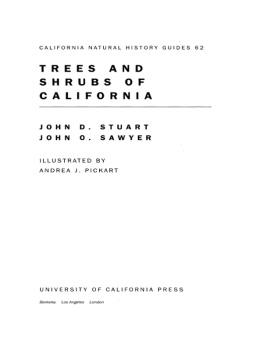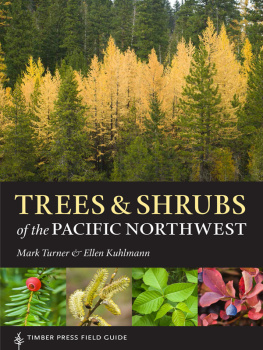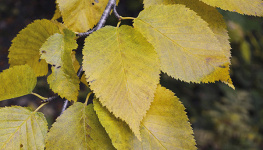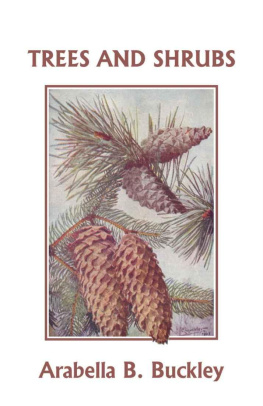Dirrs Encyclopedia of Trees and ShrubsMICHAEL A. DIRR
 , late May 2008.
, late May 2008.
Pages : Daphniphyllum macropodum Copyright 2011 by Michael A. Dirr. All rights reserved. All photographs are by the author. Published in 2011 by Timber Press, Inc.
The Haseltine Building
133 S.W. Second Avenue, Suite 450
Portland, Oregon 97204-3527
www.timberpress.com 2 The Quadrant
135 Salusbury Road
London NW6 6RJ
www.timberpress.co.uk Library of Congress Cataloging-in-Publication Data is available
Catalog records for this book are available from the British Library. eISBN 978-1-60469-743-8
About the Author
MICHAEL A. DIRR is a professor of horticulture at the University of Georgia. He is the author of twelve books, including Dirrs Hardy Trees and Shrubs: An Illustrated Encyclopedia and the text and reference book, Manual of Woody Landscape Plants, and has published more than 300 scientific and popular papers and articles. His teaching, lectures, seminars, garden study tours, and plant introduction programs have contributed enormously to greater horticultural awareness.
He has received the highest teaching and gardening awards from the University of Georgia, American Society of Horticultural Science, American Horticultural Society, American Nursery & Landscape Association, Massachusetts Horticultural Society, Southern Nursery Association, and Garden Club of America.  To Roger Milliken
To Roger Milliken
mentor, friend, and advocate for Noble Trees 
Contents

Introduction
Timber Press and I have developed a symbiotic relationship in our quest/journey to produce worthy books that gardeners would embrace and enjoy.
Dirrs Hardy Trees and Shrubs (1997),
Dirrs Trees and Shrubs for Warm Cli-mates (2002),
Hydrangeas for American Gardens (2004), and
Viburnums (2006) have found niches in the gar-den and nursery circles. This encyclopedia builds on the foundations of the
Hardy and
Warm Climate books, with more than 3,500 photographs of species and cultivars in 380 genera, with an emphasis on the best new introductions of the past ten to 15 years. The garden and nursery worlds have changed dramatically in that time. Independent garden centers have waned, while Home Depot, Lowes, Wal-Mart, and other mega-chains command greater percentages of green good sales.
Be advised that the mass merchandisers are actively pursuing new plants to entice customers. Reflecting these advances are the increases in plant patents, which allow the owner to control the licensing of the product. In 1996 (66 years after the Plant Patent Act was in-stituted), approximately 10,000 plant patents were granted; in 2010, the number was over 21,000. This increase reflects the desire of breeders and introducers to protect their intellectual property. Also, many plants are not patented, but introduced for the greater good. The new plant tsunami literally swamps horticulturists and gardeners will and ability to stay current.
The rush to market is based on competition among breeders and introducers who have similar plants. The financial advantage is often weighted toward the first mover. Testing and trialing for many woody plants are minimal, and marketing supersedes the reality of performance. In this tome, I provide the best assessment possible based on testing data, research reports, performance in nurseries and gardens, and evaluations at our breeding company in Watkinsville, Georgia, Plant Introductions, Inc. (www.plantintroductions.com). Take variegated leaf cultivars of Abeliagrandiflora, now numbering about 17.
Many are unstable, produc-ing green, albino, and other shoot permutations not typical of the original cultivars. I have bred, evaluated, tested, trialed, se-lected, grown, and introduced abelias, and Hopleys (Aghop), rebranded Twist of Lime, has been one of the most stable, consistently true to type. Does this mean that someone else could have a different experience? Absolutely!  Lagerstroemia Cherry Dazzle, a superior red-flowered, genetically compact selection from the authors breeding program. Cross-referencing the Hydrangea paniculata cultivar trials at the Royal Horticultural Society (www.rhs.org.uk) with my Georgia evaluations reflects dichotomies of results. For example, RHS Trials Bulletin 23 (December 2008) evaluated more than half of the more than 80 known cultivars. Best (three stars) were Big Ben (lousy in Georgia), Dolly (lousy in Georgia), Kyushu (lousy in Georgia), Limelight (very good in Georgia), Pinky Winky (poor in Georgia), and so forth.
Lagerstroemia Cherry Dazzle, a superior red-flowered, genetically compact selection from the authors breeding program. Cross-referencing the Hydrangea paniculata cultivar trials at the Royal Horticultural Society (www.rhs.org.uk) with my Georgia evaluations reflects dichotomies of results. For example, RHS Trials Bulletin 23 (December 2008) evaluated more than half of the more than 80 known cultivars. Best (three stars) were Big Ben (lousy in Georgia), Dolly (lousy in Georgia), Kyushu (lousy in Georgia), Limelight (very good in Georgia), Pinky Winky (poor in Georgia), and so forth.
The take-home lesson: biology is shades of gray, and dogmatic acceptance of anyones results is foolish. Use these data as guides to the superior introductions. Show me your garden and I shall tell you what you are. This Alfred Austin quote captures Bonnies and my love of garden-making. As an introduction to the Warm Climate book, I textually and photographically walked the reader through our then 23-year-old garden, and many readers commented positively about seeing it. Unfortunately, the home and garden in the 2002 book are no more, as we sold and moved to Chapel Hill, North Carolina, for medical reasons, to care for our youngest daughter, Suzanne.
After existing in an apartment for six months (no garden), we de-cided to purchase a home, develop a garden, and live a normal life. The landscape (initially with bargain-basement butterfly-bushes, abelias, and Indian hawthornsall eliminated) was transformed into a garden with color, fragrance, diversity, and seasonality. In part, it was also a test site for many new plants from our breeding program and those of colleagues. The neighbors noticed, commented, queried about the roses (Knock Out), dwarf crapemyrtles (Razzle Dazzle series), and lantanas (Chapel Hill series), and others. With delight, I watched Knock Out move around the cul-de-sac and throughout the neighborhood. This garden was spiritually and psychologically essential to Bonnies, my, and Susys well-being.
Susy, who carried the gene for cystic fibrosis, was blessed to have two double-lung transplants at UNC-CH and live a rich, full, vibrant, and meaningful life. We lost our beloved Susy to chronic rejection in January 2008.  Hydrangea macrophylla hybrid selections at Plant Introductions, Inc. Books are written on dealing with grief, but Bonnie and I find inner peace with each other and in the garden. Bonnie stated it bestthere is joy in nurturing and loving living things to their greatest genetic potential. We sold our place in Chapel Hill and returned to Athens, where in 2009 we purchased a new home on an acre and started the garden journey anew.
Hydrangea macrophylla hybrid selections at Plant Introductions, Inc. Books are written on dealing with grief, but Bonnie and I find inner peace with each other and in the garden. Bonnie stated it bestthere is joy in nurturing and loving living things to their greatest genetic potential. We sold our place in Chapel Hill and returned to Athens, where in 2009 we purchased a new home on an acre and started the garden journey anew.
Next page







 , late May 2008.
, late May 2008. To Roger Milliken
To Roger Milliken

 Lagerstroemia Cherry Dazzle, a superior red-flowered, genetically compact selection from the authors breeding program. Cross-referencing the Hydrangea paniculata cultivar trials at the Royal Horticultural Society (www.rhs.org.uk) with my Georgia evaluations reflects dichotomies of results. For example, RHS Trials Bulletin 23 (December 2008) evaluated more than half of the more than 80 known cultivars. Best (three stars) were Big Ben (lousy in Georgia), Dolly (lousy in Georgia), Kyushu (lousy in Georgia), Limelight (very good in Georgia), Pinky Winky (poor in Georgia), and so forth.
Lagerstroemia Cherry Dazzle, a superior red-flowered, genetically compact selection from the authors breeding program. Cross-referencing the Hydrangea paniculata cultivar trials at the Royal Horticultural Society (www.rhs.org.uk) with my Georgia evaluations reflects dichotomies of results. For example, RHS Trials Bulletin 23 (December 2008) evaluated more than half of the more than 80 known cultivars. Best (three stars) were Big Ben (lousy in Georgia), Dolly (lousy in Georgia), Kyushu (lousy in Georgia), Limelight (very good in Georgia), Pinky Winky (poor in Georgia), and so forth. Hydrangea macrophylla hybrid selections at Plant Introductions, Inc. Books are written on dealing with grief, but Bonnie and I find inner peace with each other and in the garden. Bonnie stated it bestthere is joy in nurturing and loving living things to their greatest genetic potential. We sold our place in Chapel Hill and returned to Athens, where in 2009 we purchased a new home on an acre and started the garden journey anew.
Hydrangea macrophylla hybrid selections at Plant Introductions, Inc. Books are written on dealing with grief, but Bonnie and I find inner peace with each other and in the garden. Bonnie stated it bestthere is joy in nurturing and loving living things to their greatest genetic potential. We sold our place in Chapel Hill and returned to Athens, where in 2009 we purchased a new home on an acre and started the garden journey anew.